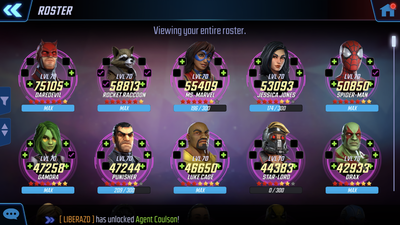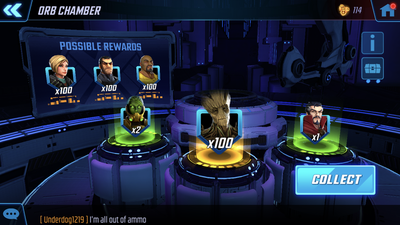MARVEL Strike Force
After reading a particularly deep and persuasive Game Informer opinion piece, I decided to download MARVEL Strike Force as a way to take occasional breaks from the stress of planning our wedding. In a polished experience centering on collecting and upgrading MARVEL characters, I soon found myself assembling five-character teams of heroes, villains, and minions whose compositions rivalled even the wildest Cinematic Universe crossovers to date. My early game mashup team of Spiderman, Elektra, Crossbones, Luke Cage, and an unnamed S.H.E.I.L.D. Medic was soon taking on the likes of Ultron, Hydra, and other players' amalgamations in an effort to — as always — save the world.
The campaign offers a barebones and comic-book-absurd explanation of what’s going on: a new villain named Ultimus (who was invented for this game) has a Conversion Device that he uses to corrupt heroes and villains alike to join his cause. Ultimus conveniently also has the ability to open interdimensional portals, so he makes a habit of converting whole armies of Avengers, Guardians, Hydra, Kree, etc. in his ongoing conquest of the multiverse. Naturally, our dimension — and specifically, our Earth — contains Nexus portals that guard the way to all other dimensions, so Ultimus sees our dimension as his prize. Conveniently, our dimension’s Nick Fury secretly started a S.H.E.I.L.D. division called S.T.R.I.K.E. to monitor and defend against inter-dimensional threats, hence the whole “Strike Force” thing. So, in a classic “the enemy of my enemy is my friend” narrative, our dimension’s heroes and villains team up under the Strike Commander (that’s you) to fight Ultimus and — cue the heroic fanfare — save the multiverse!

I’m just going to get this out of the way now: MARVEL Strike Force’s main story (and many side- and event-stories) are terrible. The writers can’t seem to decide if they’re self-aware of how silly the whole setup is or if they take it very seriously, which leads to almost all the characters delivering similar, melodramatic lines. Even characters who were created to leverage our cracking suspension of disbelief (like Deadpool and Star Lord) fall flat. That being said, MARVEL Strike Force is primarily made up of its many well-executed variations of the same core, turn-based strategy gameplay, and the forgettable story is really just there to tie everything together.
With that negative aside, let’s talk about a bunch of things MARVEL Strike Force does really well. First, as hinted at before, it has a lot of different game modes. And somehow, almost all of them feel enjoyable and distinct despite not being terribly different from one another. For example, the Campaign mode tasks the player with using different subsets of characters (only heroes, only villains, only characters from space, etc.) to play though a sequence of levels. In the Arena, players fight for better ladder rank by pitting their best five-character team against those of higher-ranked players. In Blitz, players use their entire collection of characters to win as many battles as they can in the period of a couple days. In Raids, players work with their alliance to collectively complete a map of difficult battles.

You might be thinking “Okay, we get it, every mode is basically a different framework for battles. Doesn’t that get old? Why play all the different modes?” The best answer I can give is that MARVEL Strike Force’s many modes enable and encourage progression in a way that is exceptionally better than many of its free-to-play peers. In order to explain how it does this, we need to understand how characters are upgraded. First, a character has to be unlocked by collecting some number of that character’s “shards.” Some shards can be obtained through completing/replaying Campaign levels, while others come as rewards from orb drops (MARVEL Strike Force’s equivalent of a loot box). Once a character’s been unlocked, they can be upgraded in five ways:
- Stars: Gaining additional shards periodically increases a character’s star level (up to star level 7), which increases the character’s power.
- Red Stars: Random drops that dramatically increase character power (and the one and only pay-to-win feature of this game).
- Level: Players can spend gold and “training modules” to increase the character’s level, which maxes out at the player’s level (which is increased by gaining XP).
- Abilities: Each character has up to three active abilities and one passive to use in battles, and each ability can be upgraded using “ability materials”.
- Gear: A character’s stats (health, damage, armor, etc.) can be increased by upgrading their gear, which can be obtained from Campaign levels.
This may all feel overly complicated, but the reality is that these convoluted systems encourage players to engage in everything the game has to offer, all while rewarding that engagement with tangible and meaningful upgrades to their characters. Being a free-to-play game, this approach helps players remain relatively competitive without having to empty their wallets. (There’s one necessary caveat to this point: for those who do want to shell out some cash, the in-app purchases in MARVEL Strike Force are stupidly expensive).
The second free-to-play sin that MARVEL Strike Force neatly avoids is unnecessary grinding (especially for free players to progress). Instead of making you play Campaign level over and over again, for example, beating a level without any of your characters dying unlocks an “auto-win” of that level, where you can simply spend Campaign energy and immediately get the rewards (shards, gold, gear, etc.). With a tap of a button, I can auto-win a level ten times, a task that would usually take at least 10 minutes. Other small details like this one really add up in a way that makes me feel good about playing (instead of worrying that I’m falling prey to time-sucking strategies the developer may be employing).
The meta-game has pretty severe balance issues (at the time of writing, Defenders and S.H.E.I.L.D. teams have been essentially unbeatable at the highest levels of competition for months) and the main UI is unnecessarily cumbersome, but if you’re looking to play with a wide cut of MARVEL’s roster for free in a pretty friendly community, I’d be hard pressed to find a better recommendation than MARVEL Strike Force.
Notes
As of writing this review, I’ve been playing MARVEL Strike Force for 6.5 months, have been in two alliances (other than the default one), have reached the maximum level (70), and am easily completing Ultimus V raids. I have not completed any of The Dark Dimension. Alliance War was added after this was written.
Bugs
Occasionally, after certain updates, battles can hang indefinitely, where either the AI never takes their turn or the player is never presented with their actions. This is usually fixable by force-quitting the game and restarting.